In a quest for upper back size and strength, and the muscular silhouette that comes with it, lifters are increasingly finding room for a unique rowing exercise in their back-building routines. The barbell high row, sometimes called the wide row, is a bent-over barbell row performed with a distinctive setup and arm path that hammers the entire upper…
The post How to Do the Barbell High Row for a Powerful, Muscular Upper Back appeared first on Breaking Muscle.
In a quest for upper back size and strength, and the muscular silhouette that comes with it, lifters are increasingly finding room for a unique rowing exercise in their back-building routines. The barbell high row, sometimes called the wide row, is a bent-over barbell row performed with a distinctive setup and arm path that hammers the entire upper half of your back, especially your mid-back and shoulders.
While bent-over rows and reverse flyes are traditional choices to target these regions, the barbell high row offers distinct mechanical advantages that promote targeted loading and honest form.
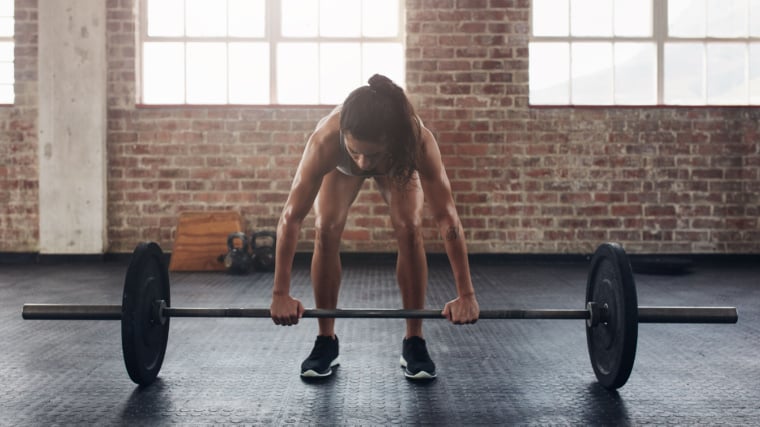
The barbell high row is an old school exercise enjoying widespread recognition. Whether you use it to round out an intense back workout or to round out the backsides of your shoulders, the barbell high row is a solid addition to any lifting routine.
Barbell High Row
- How to Do the Barbell High Row
- Barbell High Row Mistakes to Avoid
- How to Progress the Barbell High Row
- Benefits of the Barbell High Row
- Muscles Worked by the Barbell High Row
- How to Program the Barbell High Row
- Barbell High Row Variations
- Frequently Asked Questions
Barbell High Row Video Guide
Dr. Merrick Lincoln, the article’s author, provides an instruction video explaining the barbell high row. Watch the demonstration, then check out the step-by-step analysis with more form tips.
How to Do the Barbell High Row Step By Step
To get the benefits of the barbell high row, you’ll need to focus on crisp, strict form. Execute pristine barbell high rows with these four steps.
Step 1 — Take a Wide Grip
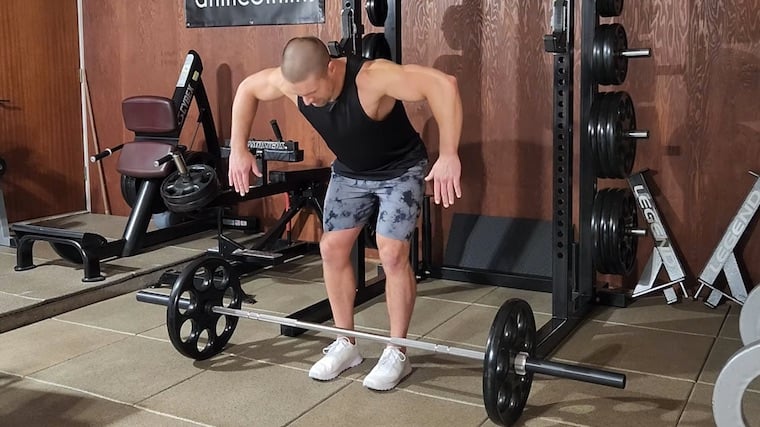
The barbell high row uses a significantly wide overhand grip — specifically, a “snatch grip” similar to the Olympic weightlifting exercise. Your hands should grab the bar substantially beyond your shoulders and approximately the distance between the points of your elbows when your arms are outstretched at shoulder-height.
Form Tip: Rather than getting the measuring tape, a simple technique to determine an appropriate grip width is to grab the bar in the “scarecrow position:” bend forward, flare your elbows to shoulder-height, and allow your forearms to hang with your elbows at an approximately 90-degree angle. Grab the bar at this width.
Step 2 — Stand Up, Then Hinge Down
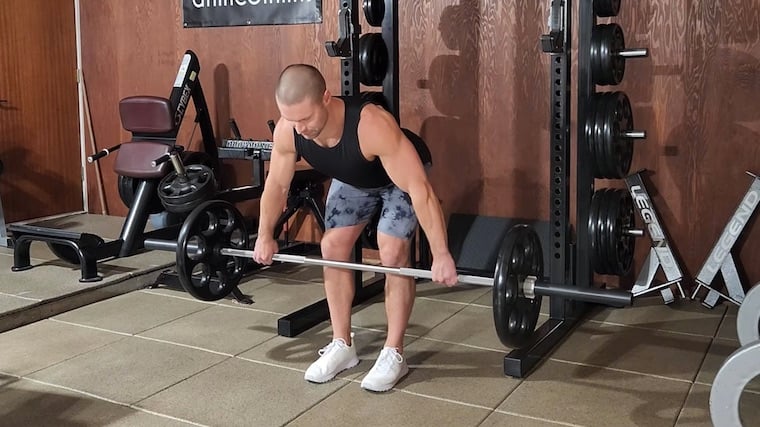
Grip the bar firmly and stand up straight, allowing your elbows to straighten with the barbell resting near your hips. Hinge forward at your hips, letting your hips flex as your buttock travels backward to keep you balanced. The position of your spine should remain virtually unchanged — no rounding. Keep a slight bend in your knees throughout the movement.
Form Tip: Lower until you feel a stretch in your hamstrings (behind your thighs) or when the plates are hovering just above the ground, whichever comes first.
Step 3 — Pull High and Wide
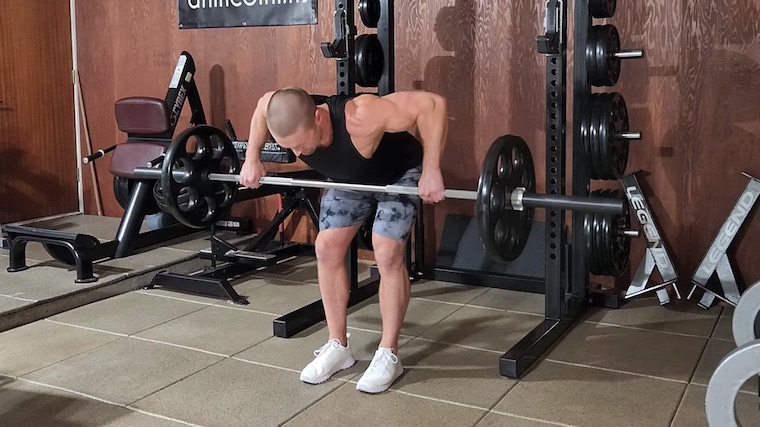
Hold the bent position and pull the barbell toward your upper chest, or just below your collarbone, by simultaneously driving your elbows out to your sides while drawing your shoulder blades together. Not all lifters will be able to touch the barbell to the upper chest, and that is okay.
Form Tip: Think about “stretching” the bar or making it longer as you pull. This cue reinforces proper arm path. Ensure your elbows remain flared to the sides and not alongside your ribs.
Step 4 — Lower With Control
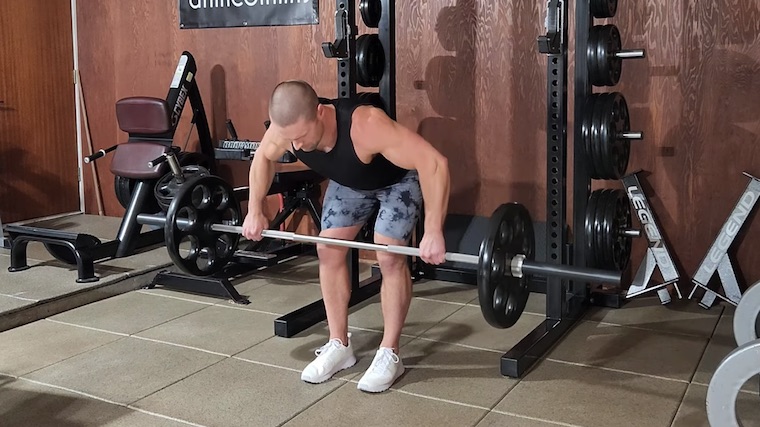
Lower the barbell toward the floor by allowing your elbows to straighten and your shoulder blades to be pulled apart, moving forward around your ribcage. Maintain the hinged forward position and repeat the pull for additional rowing repetitions
Form Tip: Don’t miss out on the stretch across your mid-back at the bottom. Ensure your trunk angle or hip hinge depth allows you to get a full range of motion without the barbell plates touching the ground. If you’re flexible and the weight plates hit the floor before you feel the stretch, reset your trunk angle by extending your hips or load the bar with smaller diameter plates.
Barbell High Row Mistakes to Avoid
The barbell high row involves stability and a degree of coordination between your upper and lower body. Keep exercise quality high by avoiding these recurring errors.
Using Too Much Biceps
Training your biceps is nice, but hitting the target muscles of your shoulders and back is nicer. It has been suggested that rowing with greater than 90-degrees of elbow flexion increases contribution of the biceps brachii. (1)

Moreover, rowing with excessive elbow flexion reduces the resistance arm, or perpendicular distance between the barbell and the shoulder joint, which ultimately reduces demand on the shoulder musculature.
Avoid it: Avoid letting your biceps steal the row by using appropriate grip placement, setup, and technique. First, ensure your grip is overhand and spaced approximately the distance between your elbows when your arms are at shoulder-height. Second, when you hinge forward to set up, ensure the bar is hanging underneath your upper chest. Finally, pull toward your upper chest, not your stomach.
Poor “Scapulohumeral Rhythm”
As you pull your arms back, or horizontally abduct your shoulder joint, your shoulder blades ought to come together, or retract. The coupling of shoulder joint motions with appropriate shoulder blade motions is called scapulohumeral rhythm. If your blades aren’t working with your shoulder joints, well, you’ve got no rhythm.
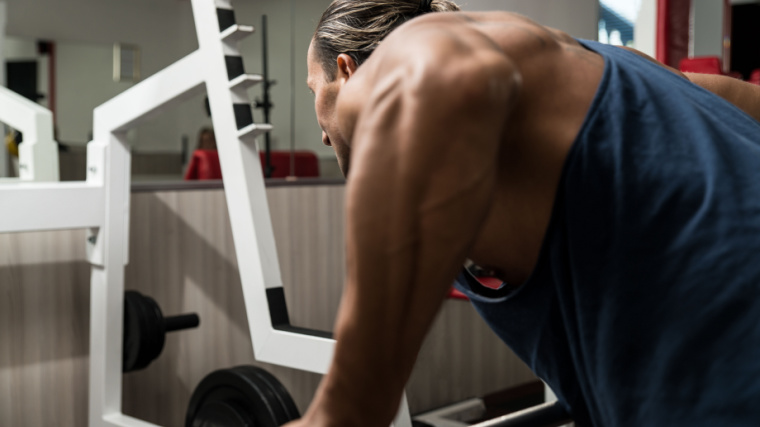
Avoid it: Draw your shoulder blades back as you perform the upward movement phase of the row. A useful cue is to create progressively more space between the front of your shoulder and the floor as you row. (2) Then, allow this space to shrink as you perform the downward movement phase.
Momentum from Your Hips or Trunk
While the upward movement phase of the repetition should be performed with powerful intent, form should not be compromised. If the angle between your trunk and the floor dramatically changes during each repetition, with your torso dipping up and down, you’re cheating and likely sacrificing tension on the target muscles.

Avoid it: If you cannot fix this error by stiffening your midsection and consciously keeping a tight core, it may be time to reduce the weight and put in some more practice sets.
How to Progress the Barbell High Row
Once the barbell high row begins to feel relatively easy, you need progression to ensure ongoing gains. Based on your goals and preferences, consider the following strategies.
Add Repetition Volume
Unlike the bench press, no one will ever ask how much weight you can barbell high row, because no one really cares. So, rather than adding weight when your sets of barbell high rows start to feel “easy,” simply add another repetition or two per set.
Provided your sets have not become miniature endurance events limited by other energy systems, gradually progressing into higher repetition ranges can be effective for building muscle. (3)
If you’re a physique-focused lifter who enjoys moderate-to-high volume sets, and your sets are still under 25 or 30 repetitions, continue to add repetitions until your sets become challenging again.
Increase the Weight
Adding more repetitions may stimulate ongoing muscle growth, but it may not be the best option for building strength in your back and shoulders. Strength, defined as the ability to exert force in a measurable and meaningful way, is logically best developed using progressively heavier loads.
If you are a strength-focused athlete who is consistently hitting six or more repetitions per set with some in the tank, it may be time to add some change plates to the bar. For your working sets, start by adding increments of 2 to 5% of the total weight.
Consider an Eccentric Tempo
Popular wisdom in the gym suggests using a relatively slow tempo during the downward movement (eccentric phase) can improve your gains. However, this topic is more controversial than it seems. Research on intentionally slow eccentric training is mixed when it comes to hypertrophy and appears decidedly unwise for strength goals. (4)
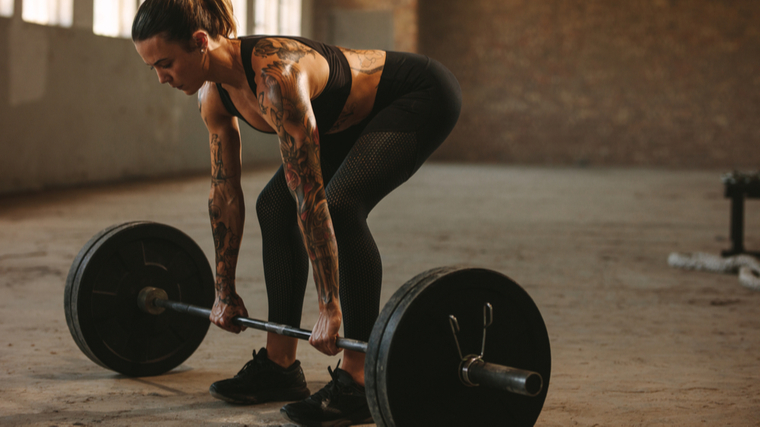
However, if you find yourself unable or unwilling to progress barbell high rows via the traditional methods discussed above (e.g., injury, lack of additional weights, or good old-fashioned stubbornness), applying an eccentric tempo may be worth consideration.
If using an intentionally slow tempo during the eccentric requires you to decrease the weight or reduce the repetitions performed, it likely does not represent a progression. (4) To be clear, using an eccentric tempo is only a progression if you impose it upon the repetitions and load your body is accustomed to. If you choose to experiment with eccentric tempo work, a lowering phase that lasts for a full three-to-four count is a reasonable target.
Finally, intentionally slowing the upward movement (concentric phase) of a lift has little to no physiological benefit. (5) So you will still want to strike the balance between intent for bar speed and control during the concentric.
Benefits of the Barbell High Row
Why are more and more lifters choosing the barbell high row to build their shoulders and backs? Because this rediscovered exercise has advantages that other common options cannot match.
Robust Shoulder Complex Training
The shoulder complex includes the shoulder joint proper (i.e., glenohumeral joint), the shoulder girdle (i.e., shoulder blade and collar bone), along with all associated muscles. While other types of rows may hit your latissimus dorsi harder, arguably no common row variation trains the back of the shoulder complex as robustly as the barbell high row.
Although we tend to classify all rowing exercises as “horizontal pulling,” the uniqueness of the high row is all about differences in angles and arm paths. Most row variations bias your shoulder extensors due to relatively narrow and low arm paths. These muscles are also trained in neutral-grip lat pulldowns, neutral-grip pull-ups, chin-ups, and other similar exercises.
However, the barbell high row trains your shoulder horizontal abductors due to the high and wide arm path. These muscles include the rear deltoid, part of the middle deltoid, and even several muscles of the rotator cuff.
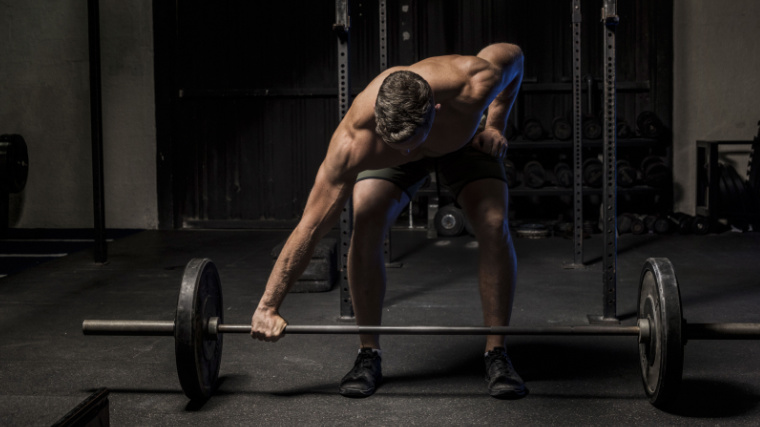
High rows may better target your mid-back, namely the middle trapezius, compared to row variations with lower arm paths (6) This finding makes sense, because the high and wide resistance applied through your arms maximizes resistance to the scapula retractor muscles.
If you are already hitting pulldowns or bent-over rows, the barbell high row might be a great addition to round out your training for the back of the shoulder complex. It can also serve as a substitute for reverse flyes, as discussed below.
Hard to Cheat
Compared to reverse flyes, a dumbbell exercise for your rear deltoids and mid-back, the barbell high row promotes strict form. It is a little too easy to generate momentum at the bottom part of a reverse flye, and that momentum helps to carry the dumbbells to the top position without significant muscular activation.
The barbell high row, on the other hand, leaves little room for generating arm swing because tension never really comes off the working muscles. What’s true for both exercises, however, is that you must still remain vigilant to avoid momentum from your hips. This can be accomplished by carefully maintaining the same trunk angle, or distance between your trunk and the floor, throughout the exercise.
Low Back Health
If you could collect a dollar every time you see an exercise purported to “bulletproof” the low back, you could quickly buy a barbell and build strength and endurance with hip hinge or forward-bent exercises.
Barbell exercises that load the hip hinge include deadlifts, good mornings, bent-over rows, and high rows. They’re all effective for training the spinal erector muscles. For this reason, among others, these exercises may be useful for combating low back problems. For example, the Pendlay row has been used as a part of an effective resistance training protocol for individuals with low back pain. (7)
The barbell high row is an effective exercise for building low back strength and endurance. Will the exercise “bulletproof” your low back? Not in the literal sense, but it may be worth a shot for potentially preventing back problems or treating appropriate types of low back pain.
Disclaimer: All brands of low back pain are different. If you are suffering from low back pain or injury, you should get checked out by a sports medicine physician or physical therapist.
Muscles Worked by Barbell High Row
While traditional bent-over rows and reverse grip bent-over rows are great for building lats due to their narrower grip and lower bar path, the barbell high row biases different muscles of your back. It’s also a phenomenal shoulder-builder.
Middle Trapezius and Rhomboids
Your mid-back muscles include the rhomboids major, rhomboids minor, and the middle part of the trapezius. Rhomboids retract your scapulae, or pull the shoulder blades together, and assist with downward rotation and elevation.
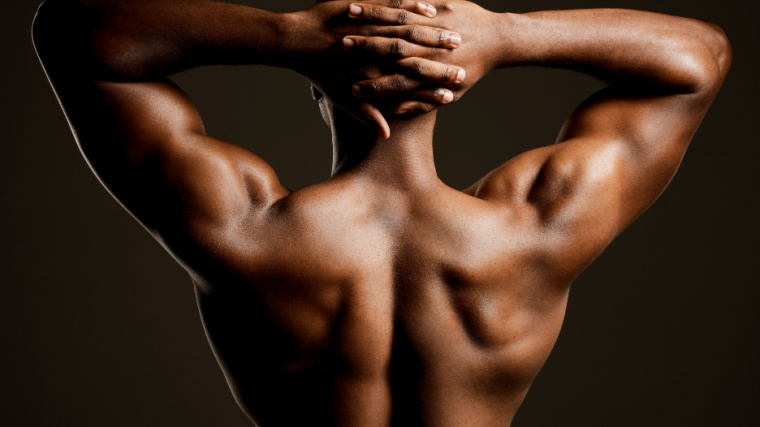
The muscle fibers of the middle part of the trapezius, sometimes called “middle traps,” are oriented horizontally, so they exclusively perform scapula retraction. Since retraction is the predominant resisted movement of the shoulder blades during the barbell high row, it hits middle trapezius and rhomboids.
Rear and Middle Deltoids
Your deltoids are the round muscles that sit atop and envelop your shoulder joints. Well-built deltoids have a “capped” or rounded appearance, which requires training the front, middle, and rear portions of the muscle. The barbell high row hammers the rear deltoids and also hits some of the middle fibers.
Rotator Cuff
The rotator cuff consists of four deep muscles and tendons that surround the ball and socket joint of the shoulder. They are typically considered stabilizing muscles, working to counteract or modify forces imposed on the joint by much larger superficial muscles. During rows, the subscapularis, or anterior rotator cuff, has been shown to be most active. (8)
In addition, anatomical analysis of the posterior rotator cuff (infraspinatus and teres minor) suggests these muscles may also be trained along with the posterior deltoid during the barbell high row. Both muscles pass behind the shoulder joint and are mechanically suited to act as horizontal abductors.
How to Program the Barbell High Row
The barbell high row can be programmed in a full-body workout or in a variety of workout splits. As a multi-joint pulling exercise, the barbell high row can be used to build functional strength or as an efficient way to pack on mid-back and shoulder muscle.
As a Moderate Weight Back-Builder
Lifters with hypertrophy or muscle-building goals should focus on moderate weight sets of barbell high rows. As a rule of thumb, you will use 30-50% less weight for the barbell high row than you do for standard bent-over barbell rows.
For those reaching for calculators or scrolling for calculator apps, relax. There is no need to overthink the weight and repetition range. As long as your sets are high effort, or carried out close to muscular failure, they will be effective at virtually any weight. (3)(9) To put on muscle, perform three or four sets of eight or more repetitions, taking each working set to within two or three repetitions of failure. Rest two or three minutes between sets.
As a Strength Staple
Load barbell high rows with relatively heavy weight, and you’ve got a potent exercise for building upper back and shoulder strength. As the weight increases, stay disciplined with your form. Extending your hips to initiate the row shifts emphasis from your upper body to your lower body.
To build pulling strength, perform three or four sets of four to six repetitions using a challenging weight. Rest two to four minutes between sets.
As Part of a Superset
Using supersets refers to two different exercises performed back-to-back without a rest interval in between. It’s a time-efficient training method, if you’re tough enough to handle it. In the strictest sense, the two exercises comprising a superset should target antagonistic or opposite muscle groups.
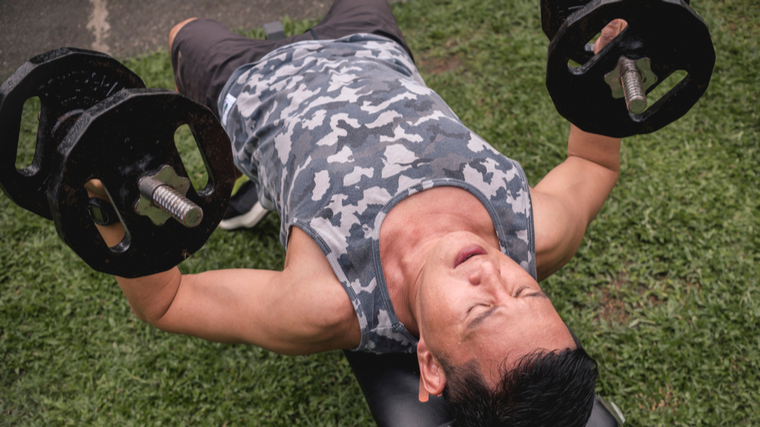
Since the barbell high row is a horizontal pulling exercise primarily targeting the back and rear deltoids, its superset counterpart should be a horizontal pushing exercise that hits the chest and front of the shoulders. Appropriate “pushing” exercise options for this push-pull superset include the time-honored bench press, the dumbbell hex press, or the dumbbell bench press.
Supersets save time, and research indicates lifters experience similar hypertrophy gains compared to straight sets. (10) While supersets are known to result in greater perceived exertion and discomfort, most lifters prefer them over traditional straight sets. (11) For an efficient workout, perform a pressing exercise immediately followed by the barbell high row with no rest in between.
Barbell High Row Variations
Looking for other effective exercises to build your mid-back and shoulders? The row variations below use barbells, dumbbells, resistance bands, and machines to spice up your workout.
Meadows Row
Another increasingly popular type of exercise uses a barbell as a lever. They’re called landmine exercises. (2) The Meadows row is a single-arm high row landmine exercise. It was popularized by the late coach John Meadows, MS, CSCS.
Aside from the ability to perform the movement unilaterally, a feature making the Meadows row unique is the resistance curve of the exercise. The barbell lever makes the row “heavier” at the bottom position. (2) Keep in mind, you’re stronger at the bottom of the rowing motion than you are at the top. (2)
Also, the target muscles of the mid back and shoulders are stretched at the bottom position while they are exposed to greater loads. These features can make the Meadows row incredibly effective for building pulling capacity and stimulating stretch-mediated hypertrophy.
Resistance Band High Row
Resistance band exercises are great for warm-ups, accessory exercises, pump-work, and travel. The resistance band high row allows for quick setup and performance of the high row movement in an upright position.
To perform resistance band high rows, simply anchor a resistance band securely at the level of your upper chest and take an overhand grip on the band — slightly wider than shoulder-width if using a loop-style resistance band. With your arms at shoulder height, back up into tension. Pull the handles high and wide, leading with your elbows, to bring the band to your upper chest before returning to the starting position. Be sure not to turn the movement into a face pull by pulling the band to eye-level.
Three-Point Dumbbell Wide Row
The dumbbell wide row is the single-arm version of the barbell high row. (1) Using a three-point stance on a bench provides the support you may need to zero-in on target muscles.
Set up by placing the non-working side knee and palm on the bench, with your working-side foot on the floor, and the dumbbell in the working-side hand. Drive your elbow out the side as you pull toward the upper chest. Return to the starting position while allowing your shoulder blade to “wrap forward” around your ribcage.
Machine Wide Row
Support and guidance offered by a well-built machine can help to ensure your rear deltoids and mid-back receive the intended training stimulus from wide rows. The machine can also minimize demands on your low back, which can be useful when managing fatigue throughout a grueling workout.
Find a row machine with wide-set horizontal handles. Adjust the seat to allow a high arm path toward your upper chest. Take overhand grips on the handles and draw the machine’s movement arms back. Like the barbell version, drive your elbows out to your sides and retract your shoulder blades as you pull. Reverse the movement to return to the start position.
FAQs
While both exercises are performed from the hip hinge position with overhand grips, the barbell high row uses a significantly wider grip. Due to the wider grip, the natural bar path for the high row is “higher” as the bar is pulled toward the upper chest, while the bent-over row is pulled toward the lower chest or upper stomach.
The barbell high row uses a grip significantly wider than the shoulders and begins with the barbell suspended in the air while maintaining a hip hinge position. The Pendlay row uses an overhand grip that’s slightly wider than the shoulders and each repetition begins from a dead-stop on the floor.
Once again, the difference in grip width results in different natural bar paths. While the barbell high row bar path leads toward the upper chest, the Pendlay row is directed toward the lower chest. (7)
Some coaches encourage lifters to retract or set their shoulder blades prior to initiating the row. While this could be useful as a very early teaching drill, training using this technique is misguided.
During functional movements like a row, the shoulder joints and shoulder blades should work together to accomplish the task. While retraction is the appropriate movement of the scapulae, performing it prior to the row limits the tension the mid-back is exposed to during the row. The dynamic retraction work is already complete before movement of the upper arm bone amplifies the resistance arm.
We know muscles are stronger isometrically than concentrically, so simply holding the retracted position during the most challenging portions of the row will fail to stimulate as much mid-back growth as performing rows the correct way — retract as you row.
That’s an option. Both exercises train your spinal erector muscles. Deadlifts were part of the low back pain protocol study discussed above, and additional evidence suggests deadlifts may be useful for individuals suffering from low back pain. (7)(12)(13)
However, there are a few reasons the barbell high row might be favored over deadlifts. The barbell high row uses substantially less weight than deadlifts, which may result in less compressive loading through the spine. But the bar path of the high row is farther from the lumbar spine than it is in the deadlift, meaning the barbell has a larger resistance moment arm. The longer resistance arm applies proportionately larger torque or demand on the low back, which is ultimately counteracted by the spinal erectors.
Finally, during the row, the lifter remains hinged forward at the hips throughout the entire set, which may lead to the development of greater muscular endurance in the low back. Both are great exercises. Again, if you are suffering from back issues, consult a sports medicine physician or physical therapist for individualized advice.
Build a Top-Level Physique with the Barbell High Row
The barbell high row is an effective exercise for adding muscular thickness behind the shoulders and between the shoulder blades. Over time, this new muscle will fill out the top half of your physique. Better yet, to help keep you in the gym long enough to realize those gains, the barbell high row also promotes shoulder and low back stability.
References
- Hedrick, A., & Herl, M. (2021). Technique of the unilateral dumbbell wide row. Strength & Conditioning Journal, 43(4), 121-123.
- Lincoln, M. A., et al. (2023). Exercise Technique: The Landmine Row. Strength & Conditioning Journal, 45(3), 371-378.
- Schoenfeld, B., et al. (2021). Resistance training recommendations to maximize muscle hypertrophy in an athletic population: Position stand of the IUSCA. International Journal of Strength and Conditioning, 1(1), 1-30.
- Suchomel, T. J., et al. (2019). Implementing eccentric resistance training—part 1: a brief review of existing methods. Journal of Functional Morphology and Kinesiology, 4(2), 38.
- Hermes, M. J., & Fry, A. C. (2023). Intentionally Slow Concentric Velocity Resistance Exercise and Strength Adaptations: A Meta-Analysis. Journal of Strength and Conditioning Research, 37(8), e470-e484.
- Lim, J. Y., et al. (2015). A comparison of trapezius muscle activities of different shoulder abduction angles and rotation conditions during prone horizontal abduction. Journal of Physical Therapy Science, 27(1), 97-100.
- Tjøsvoll, S. O., et al. (2020). Periodized resistance training for persistent non-specific low back pain: a mixed methods feasibility study. BMC Sports Science, Medicine and Rehabilitation, 12, 1-12.
- Wattanaprakornkul, D., et al. (2011). Direction-specific recruitment of rotator cuff muscles during bench press and row. Journal of Electromyography and Kinesiology, 21(6), 1041-1049.
- Weakley, J., et al. (2023). Physiological Responses and Adaptations to Lower Load Resistance Training: Implications for Health and Performance. Sports Medicine-Open, 9(1), 1-10.
- Fink, J., et al. (2021). Physiological Responses to Agonist–Antagonist Superset Resistance Training. Journal of Science in Sport and Exercise, 3, 355-363.
- Andersen, V., et al. (2022). A comparison of affective responses between time efficient and traditional resistance training. Frontiers in Psychology, 13, 912368.
- Aasa, B., et al. (2015). Individualized low-load motor control exercises and education versus a high-load lifting exercise and education to improve activity, pain intensity, and physical performance in patients with low back pain: a randomized controlled trial. Journal of Orthopaedic & Sports Physical Therapy, 45(2), 77-85.
- Welch, N., et al. (2015). The effects of a free-weight-based resistance training intervention on pain, squat biomechanics and MRI-defined lumbar fat infiltration and functional cross-sectional area in those with chronic low back. BMJ Open Sport & Exercise Medicine, 1(1), e000050.
Featured Image: Paul Aiken / Shutterstock
The post How to Do the Barbell High Row for a Powerful, Muscular Upper Back appeared first on Breaking Muscle.







